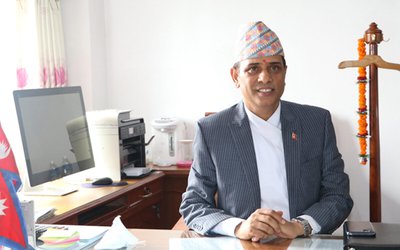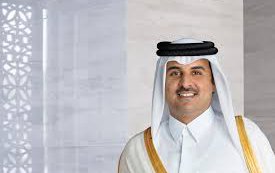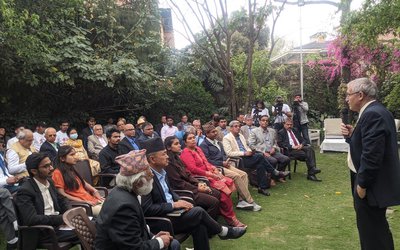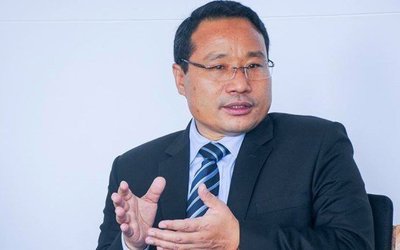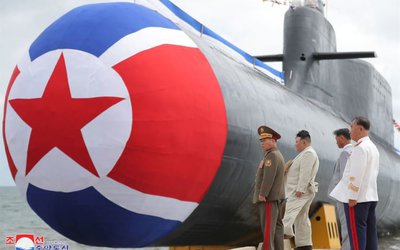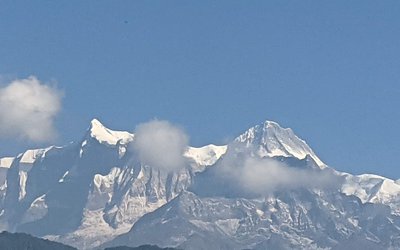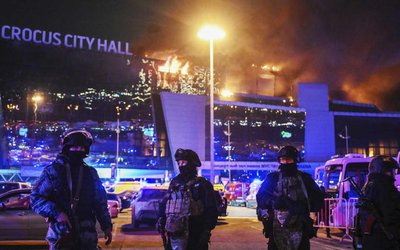With the 3-day state visit to Nepal by Indian president Pranab Mukherjee, Nepal and India have narrowed down the gaps that had existed in their bilateral relationship.
Indian president Mukherjee repeatedly mentioned that India’s relations with Nepal were centuries old, with the two countries sharing civilization, religion and culture. Nepali leaders reciprocated with him. They left no stone unturned to show how Nepal had attached high importance to its relations with India.
Although roads were blocked for security reasons and severe criticisms were hurled around the social media regarding this, Nepali people closely watched the visit of president Mukharjee. At the official level, President Bhandari, Prime Minister Dahal and other political leaders made every possible effort for the visit to be warm and successful.
Despite their differences over political and constitutional issues, the Nepali political leaders, including K.P Sharma Oli, who is projected as anti-Indian, called upon Indian president Mukharjee.
Although a section of people, reportedly close to the largest and smallest communist parties, used the social media and streets in expressing their resentment against India, criticizing it for its role in last year's blockade, an overwhelming number of Nepali people welcomed the visit.
After the visit, Nepal-India relations have returned to their usual track as it helped bury the recent differences. Of course, certain unresolved issues, for example, in water resources and power sharing, including inundation, irrigation and trade, have remained there, the two countries have shown that they can settle the issues confronting their relations.
“With so many commonalities and close ties with India, Nepal needs to exploit the opportunities offered by India,” said former minister and Nepali Congress leader Dr. Minendra Rijal. “The recent visit of Indian president Mukherjee has been highly successful to clearly convey the message that Nepal and India can go together.”
However, the relations are not always as rosy as Dr. Rijal sees. Groomed in an unrealistic communist ideology, at a level of bankruptcy in historical and cultural knowledge, a set of Nepal’s current political leadership and their followers do not know the depth of the enormous interactions with India in all spheres of Nepali life.
Nepal and India are so close that they share the same civilization. In a sense, Nepal and India are two independent nations with one civilization. There are no other two countries in the world as similar as Nepal and India. This realization is dawning on India as well.
As American Professor Leo Rose pointed out in his book, Nepal Strategy for Survival, that Nepal’s relations with India had been intimate and continuous on virtually all level of contacts, some irritants are natural in this context.
For example, the recent Indian ban on IC Rs. 500 and Rs.1000 denominations is likely to revive misunderstanding in Nepal. The sooner the Indian Prime Minister Narendra Modi’s recently reported conversation with Nepalese prime minister to solve the currency crisis materializes, the better will be the chances to boost the confidence at the people’s level.
With geographical and cultural closeness, Nepal’s relations with India are unmatchable to any two other countries in reality. However, psychologically, ruling elites see Chinese influences in Nepal as equal to Indian influences.
With the dominant rise of the radical communist ideology, within the ruling and opposition benches, there is a perception prevailing in Nepal that favors an outmoded non-alignment, which has lost much of its significance at present. People with this perception widely prevail in political parties, media and civil society. They see a sellout in any pragmatic remark on India.
Looking back at Mukherjee's visit, although Prime Minister Dahal made no any specific statement on Nepal’s position on India’s offer for all round development, his party colleagues and former deputy Prime Minister Narayan Kazi Shrestha had already accused Prachanda’s policy as “tilted to India.”
“Indeed, a whole new historical myths, recently formulated in Nepal, aims at proving that cultural and intellectual influences from China and India have been equally important in shaping Nepali social values and culture. Factually, this is nonsense, but psychologically it makes a very good sense,” said late Rose in his book. “Nepalis had to reckon with the Indians so long and so often that they are more prone to infer the intents quickly than to observe their overt behavior. Due to high degree of intimacy between the two countries, through the ages, whatever the Indians do in actual practice is not considered as important as what the Nepalis think the Indian means."
With the Chinese, however, it is a different story. Historically, the Nepali people had so few occasions to become acquainted with the Chinese mind that they are still in the process of observing the Chinese overt behavior vis-à-vis Nepal. In spite of all that has happened between China and India in recent years, Nepali elites are still disinclined to probe into Chinese intents and motives.
In this context, negative reactions of some radical communist leaders against India’s recent offer for all round development are merely a past hangover of the era of non-alignment.
“Nepal has no option other than to walk side by side with India. This government will not squander any time to strengthen the bilateral relations with India,” said Prime Minister Prachanda.
Leaders of main opposition Communist Party of Nepal-UML are critical. Former prime ministers Madhav Kumar Nepal, Jhalnath Khanal and KP Sharma Oli criticized the foreign powers as meddling in Nepali politics. “Nepal needs to follow a balanced and non-aligned policy. We don’t need any suggestion from our friends on what Nepal needs to do or not do,” said Nepal, reacting to Indian president Mukherjee's meeting with disgruntled Madheshi leaders and his statement.
India’s policy towards Nepal is also responsible to give space to anti-Indian sentiments in Nepal. Nepal is India’s next-door neighbor. But high-level visits from India to the neighboring country have remained infrequent for years. Indian president Mukherjee was the first president to visit Nepal in eighteen years. Prime Minister Narendra Modi was the first Indian Prime Minister to visit Nepal in 17 years.
Nepal-India Bilateral meetings
If the last few months of activities are any indication, Nepal and India are coming closer on several fronts. After almost two decades of gap, India is making efforts to bring the bilateral relations closer, by holding meetings at various levels.
Nepal-India bilateral committee meetings are taking place on a range of topics from water to energy and to security. These committees are trying to settle the differences that have existed in the implementation of various projects.
The two sides revived a defunct joint commission at the foreign minister level after almost two decades. Nepal's foreign minister Dr. Prakash Sharan Mahat and Indian minister of state of external affairs M.J. Akbar recommended many agreements for ministerial level committees.
“Our meetings are highly successful. We agreed to settle the issue of power exchange agreements, water inundation, and irrigation and to implement the bilateral projects quickly,” said Dr. Mahat.
The joint commission was envisaged as a mechanism to follow up on projects of Indian assistance in Nepal. That India is looking to speed up the projects augurs well for Nepal.
India and Nepal have also decided to expedite two ongoing cross-border railway projects and start three more railway projects. Biratnagar-Jogbani and Bardibas-Bijalpura-Jaynagar are the two ongoing railway projects that are put on a fast track. Nepalgunj-Rupedia, Kakarbhitta-New Jalpaiguri, and Bhairahawa-Nautanawa are the projects the two countries are keen to begin work on.
The meetings stressed the need to complete the Hulaki Road works in the Terai and more funds for the road construction in the region and construction of an integrated check post in Biratnagar.
To ensure what the ministers have agreed upon are followed up, the first meeting of the joint oversight mechanism, which was set up to monitor and clear the bottlenecks in ongoing projects will meet in a month’s time. India has proposed a direct rail link from Kathmandu to Barahani on its border.
Security Matter
With so many linkages, Indian security analysts see Nepal is a soft belly of Indian security. Along with rising Chinese power, an upsurge of Muslim fundamentalism in the border area is another sensitive matter for Indians. With security as top priority, Indian president Mukherjee stressed the need to have a broader agreement on security.
“As our security interests are inter-linked, we must continue to consult and coordinate closely to safeguard our shared security interests,” he said while addressing a symposium on the theme of India-Nepal relations.
In recent meetings of security officials at the district levels, Nepal and India agreed to jointly monitor the border areas to stop the movement of terrorists and criminal elements. Nepal and India also agreed on sharing the intelligence report and joint patrolling in the border areas.
As Nepal's security agencies are moving closer, Nepali and Indian Armies concluded joint military exercises to enhance the understanding between the two armies. Indian Army Chief General Dalbir Singh Suhag visited Nepal and took part in the closing program.
Nepali and Indian Armies have been holding joint military exercises for the last five years to improve their capability in disaster and anti-terrorism operations and increase their mutual understanding. “Nepal Army sees this is a good opportunity to enhance the capability of Nepal Army in fighting terrorism, rescue and rehabilitation during disaster and military warfare and other aspects."
Religious Diplomacy
Although annually tens of thousands of Nepali and Indian people visit the religious sites of both the countries, this aspect has been broadly ignored at the official level. Tourists from South India regard Mukti Nath as a main pilgrim along with Pashupati. People from Bihar and Uttar Pradesh see Janaki Temple as the main shrine as well as Pashupatinath.
Visiting two important Hindu spiritual shrines Janaki Temple in Janakpur and Pashupatinath in Kathmandu, president Mukherjee has highlighted the religious dimension of India's closeness with Nepal.
“Kathmandu is not only a political capital of Nepal, but also a spiritual center for the people of the region,” said the Indian president.
Mukherjee wrote in the visitors’ book that he wished for the successful completion of the inns being built on the temple premises with India’s financial support. Pashupatinath temple was "equally revered by devotees in India and Nepal."
Reaching to Young Nepalis
Reaching out to the younger generation of Nepal, India announced that from next year, Nepalese students would be able to compete for seats in IITs.
President Mukherjee himself announced the new opportunity for the students of Nepal. “I am very happy to announce that from 2017 onwards Nepali students will have the opportunity to pursue graduate and postgraduate courses in Indian Institutes of Technology on a regular basis. For this, our Institutes of Technology will open their entrance examinations to Nepali students,” said President Mukherjee.
Political Disputes
As Nepal and India make efforts to strengthen their bilateral ties, there are issues of dispute as well. Nepal accorded a warm welcome to president Mukherjee but asserted that India should avoid interfering in the internal issues of the country.
“As far as the constitutional amendments for accommodating the aspirations of the Madhesi people are concerned, it is an internal matter of our country, because Madhesis are Nepalis and their aspirations are internal matters of Nepal,” said foreign minister Dr. Prakash Sharan Mahat.
However, leaders from the Madhesi parties took up the issue of continued denial of rights to the Madhesi people with president Mukherjee. “We told Indian president Mukherjee that the current government of Nepal under PM Prachanda is no different from the previous governments and they are not serious about addressing the grievances of the Madhesis. We will soon withdraw from the coalition if the current state of affairs persists,” said Rajendra Mahato.
Indian Foreign secretary S. Jaishankar, elaborating on the bilateral meetings between president Mukherjee and his hosts, indicated that India urged Nepal to bridge the internal differences.
“Essentially, the President said, ‘look at India’s experience’, and try to carry all sections of the population along. It is a painstaking process. It takes a lot of debate and consultation. What we are saying is: this is our experience and if you feel that there is something to be drawn, Nepal can use the same for its constitution-writing process,” said Jaishankar, briefing the media on continued conversation between Nepal and India.
“Putting the tensions behind is only one part of Mukherjee’s diplomatic assignment. It is also about looking to the future and laying out a road map for the modernization of a very unique partnership,” writes C. Rajamohan in Indian Express.
“The Modi government has promised to change this; President Mukherjee has the opportunity to signal that India is now ready to advance the economic relationship with Nepal. This can’t be just about getting Delhi’s act together on implementing major infrastructure projects. It is also about changing the nature of the frontier through trade facilitation, simplifying transit arrangements, removing non-tariff barriers, improving trans-border roads, improving the ease of business for Nepali enterprises and making life easier for Nepali citizens working in India,” writes Rajamohan.
With the abolition of monarchy, India has lost a major asset in Nepal to cope with rising radical communists and other religious fundamentalists. As India has been calling for a close cooperation and offering development packages, there is a need of moderate political force to materialize the goodwill offer.

Keshab Poudel
Poudel is the editor of New Spotlight Magazine.
- CLA: Samriddhi For Skill Development
- Apr 23, 2024
- ECONOMY: Growth At 3.3
- Apr 16, 2024
- DPM’s SHRESTHA’S CHINA VISIT High Profile, Low Key
- Apr 14, 2024
- Maha Kumbha In Barahkshetra: A Sacred Festival In Sacred Koshi (Kaushiki) River
- Apr 09, 2024
- LOSS AND DAMAGE: Upper Tamakoshi A Case
- Apr 02, 2024


